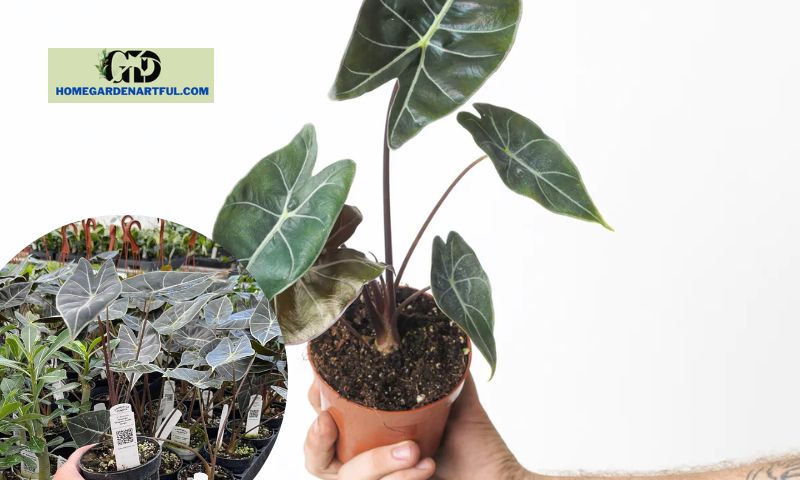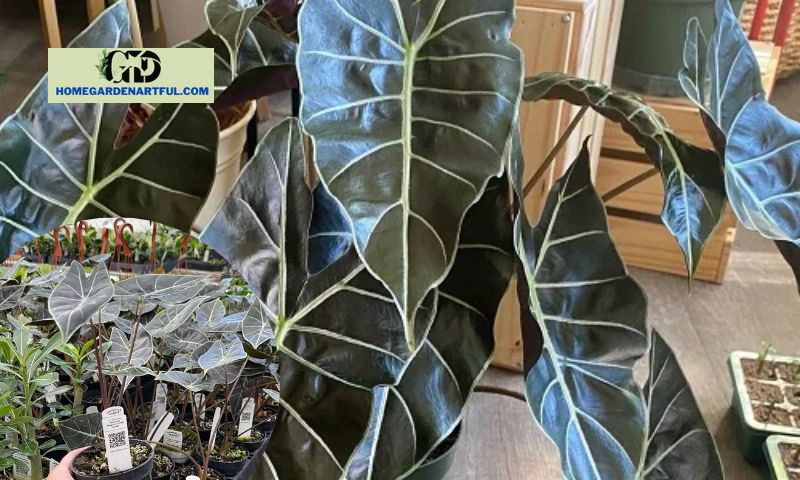All plants, particularly Alocasia Dragon’s Tooth, require light to survive. These houseplants just need six hours a day of bright indirect light to stay healthy. Alocasia can tolerate lower light levels or fewer hours of bright indirect light, but more bright indirect light is necessary for the plant to truly grow. Discover at homegardenartful.com!
Identify the Alocasia Dragon’s Tooth

Alocasia Dragon’s Tooth is a subspecies of Alocasia Longiloba, which is indigenous to Western and Central Malesia as well as Southern Yunnan and Guangdong in China. It prefers the habitat of ravines, swamp woods, exposed cliffs, bamboo thickets, limestone, cliffs, regrowth, and riverbanks, like other Alocasias.
It is a tiny to strong terrestrial herb that grows to a height of 1.5 meters from an underground rhizome. The alternating, pointy, arrowhead-shaped leaves are dark green with very noticeable light grey color veins on top and red veining beneath. The petiole is impressively obliquely mottled chocolate-brown with a dark red color.
The plant produces summer blossoms from a finger-like spadix that is surrounded by a pale green spathe. The tiny, white-to-green blossoms resemble calla flowers and are separated into male and female flowers that are spaced out along the spadix.
Alocasia Dragon’s Tooth Care Guide

Water
Dragon teeth from Alocasia have medium water needs, which means they dislike it when it’s entirely dry out but they also don’t enjoy it when there’s water standing in the area. Let the soil dry out till 3/4 of it is completely dry. It’s better to err on the side of caution and avoid using the rain head when watering Alocasia Dragon Tooth because they don’t like to be overwatered. Saturate the soil and allow the water to drain through the drainage holes in the pot when watering these houseplants. For plants like Alocasia Dragon Tooth, well-draining soil is crucial. Wet feet are absolutely intolerable to these houseplants.
Temperature
Alocasia houseplants thrive in warmer climates. The ideal temperature range for these tropical plants is 60–80°F. Avoid placing the plants next to heating or cooling vents, as well as drafts that may occur near windows and doors.
Humidity
The best for Alocasia Dragon Tooth is increased humidity. These lovely houseplants require high humidity to grow, so adding a humidifier nearby or using a pebble tray filled with water can give them the extra moisture they require.
Growing medium and substrate
Alocasia Dragon’s Tooth prefer damp, rich soil, and nearly all thrive along the edge of ponds. The plant can be grown in a few inches of standing water and introduced to water gardens as emergent plants (with the roots immersed but the plants not completely submerged).
The plant requires permeable soil with great drainage when cultivated in a pot. Peat moss, perlite, and houseplant soil combined in a perfect soil mixture. These potting mix ingredients offer good drainage and just the right amount of moisture retention. Once the plant has filled the pot entirely, repot. The plant grows best while root-bound in a small pot, which is why the pot size frequently appears relatively little in comparison to the size of the plant. Take your time transferring the plant to a bigger container.
Pruning
Throughout the growing season, the plants continuously make new leaves. To keep the plants looking neat, pluck the older leaves which gradually wither. In most cases, damaged leaves are a sign of a fungal disease, and the plant needs to be treated right away.
Fertilizer
Your alocasia will produce large, gorgeous leaves if you provide it with healthy food. During the warmer months, while the plant is actively growing, fertilize. When watering, use a complete liquid fertilizer that has been diluted 14 or fish or seaweed emulsion. Alocasia Dragon Tooth requires a time of dormancy in order to maintain its beauty. When the plant is not developing and during the colder months, avoid fertilizing.
Propagating Alocasia Dragon Tooth

Alocasia dragon tooth can be propagated via cuttings from the rhizome or by division.
Division: The plant can be divided if it has several stems or offsets and has outgrown its pot. Take care to gently separate the rhizomes after removing the plant from its container, ensuring that each division has a strong root system and at least one stem. To create clean cuts, utilize a clean, sharp knife or pair of shears. Make sure the stems are planted at the same depth as before and plant each division in its own pot of well-draining soil. Place the divisions in a warm, humid area with bright, indirect light, and lightly water them.
Cuttings from healthy rhizomes should have at least one stem and a few roots. Cut a portion of the rhizome that is a few inches in length with a clean, sharp knife or pair of shears. A minimum of one node (a little bump where leaves sprout) should be present on each cutting. In a container filled with well-draining soil, plant the cutting vertically or slightly tilted, burying the node beneath the soil’s surface. Keep the pot in a warm, humid setting with bright, indirect light, and keep the soil just barely moist.
Pro Tips
- Use a horticultural oil, such as neem oil, to regularly treat the plant and the soil. Since these indoor plants are vulnerable to pests, adopting precautions can help to maintain their beauty and health.
- For photosynthesis to be completed, plants need clean leaves. To maintain the houseplant’s stunning appearance and to help the alocasia reach its full potential, gently wipe the leaves with a damp towel.
- Don’t rush the re-potting process. Alocasia tends to remain in the same pot for a while and enjoys being slightly root-bound. It’s time to re-pot when the roots start to protrude through the holes in the grow pot or crawl out from the top of the soil.


